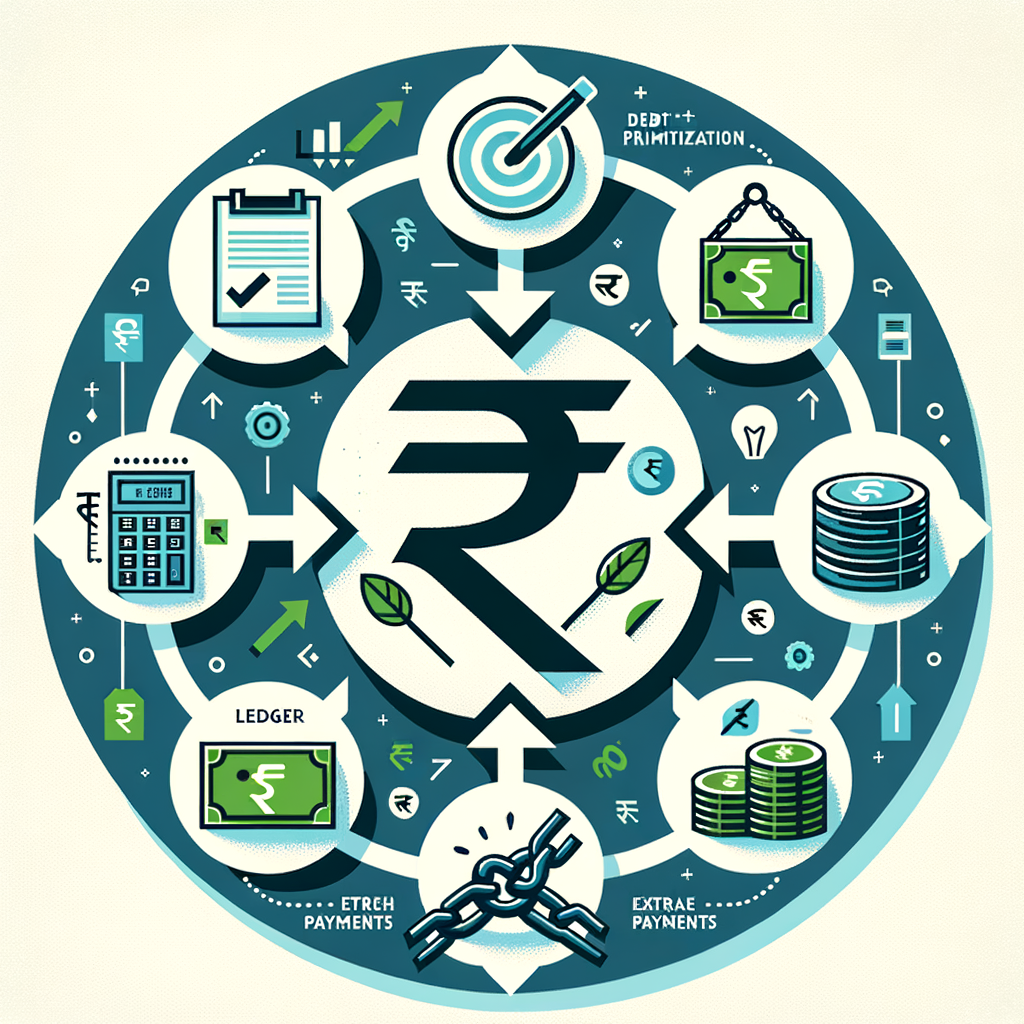7 Actionable Strategies for Paying Off High-Interest Debt in India | TaxRobo
Struggling with debt? Learn effective strategies for paying off high-interest debt quickly. Our guide covers the debt avalanche method, consolidation, and tips for salaried individuals in India.
Strategies for Paying Off High-Interest Debt Quickly
The feeling is all too familiar for many Indian professionals and small business owners. A major life event—a wedding, a medical emergency, or an urgent business expense—leads you to rely on a credit card or a quick personal loan. At first, it feels like a lifesaver. But soon, the monthly statements arrive, and the high-interest charges start to pile up, making you feel trapped. This is the difficult reality for millions, and creating a plan for paying off high-interest debt is the first, most crucial step toward regaining control of your financial future. This kind of debt can silently drain your resources, preventing you from saving, investing, and achieving long-term financial goals. This guide provides clear, actionable strategies specifically designed for the Indian context to help you break the cycle and start your journey towards financial freedom through effective high-interest debt management India.
First, Understand What You’re Up Against: Identifying High-Interest Debt
Before you can fight back, you need to know your enemy. High-interest debt is any loan or credit line that carries a significantly higher interest rate than more stable, long-term loans like a home loan. The interest you pay on this debt can quickly outpace your principal payments, creating a treadmill effect where you feel like you’re running but getting nowhere. Understanding which of your debts fall into this category is the first step toward creating an effective repayment plan.
What is Considered High-Interest Debt in India?
In the Indian financial landscape, interest rates can vary widely. However, any debt with an annual interest rate in the double digits should be considered a high priority for repayment. These loans are designed for short-term convenience but can become long-term burdens if not managed carefully.
Here are the most common culprits:
- Credit Card Debt: This is often the most expensive form of debt, with Annual Percentage Rates (APRs) frequently ranging from 24% to a staggering 48%.
- Personal Loans: While generally lower than credit card rates, personal loans from banks and Non-Banking Financial Companies (NBFCs) still carry significant interest, typically between 11% and 24%.
- Payday or Instant Loans from Apps: These short-term loans offer quick cash but often come with extremely high interest rates and fees that can translate into APRs exceeding 100% or more.
- Overdraft Facilities: Using an overdraft facility from your bank account is convenient, but the interest charged on the overdrawn amount is usually quite high, often around 18-24%.
The Vicious Cycle: Why You Must Reduce High-Interest Debt in India
High-interest debt doesn’t just cost you money; it actively works against you through the power of compounding. When you invest, compounding works in your favour, but with debt, it creates a downward spiral. The interest is calculated on your outstanding balance, and if you only make minimum payments, a large portion of your payment goes toward interest, barely touching the principal amount.
Consider this simple example: You have a ₹50,000 credit card balance with a 36% annual interest rate (3% per month).
- Your monthly interest is ₹1,500 (3% of ₹50,000).
- If your minimum payment is just ₹2,000, only ₹500 goes toward reducing your actual debt.
- At this rate, it would take you several years to clear the debt, and you would end up paying almost double the original amount in interest alone.
This cycle not only drains your income but also negatively impacts your CIBIL score. High credit utilisation and missed payments can lower your score, making it harder and more expensive to get loans for important goals like buying a home or a car in the future. Therefore, adopting the best practices for debt reduction in India is not just about saving money; it’s about securing your entire financial future.
Step 1: Create Your Debt Repayment Blueprint
Tackling a mountain of debt without a map is a recipe for failure. The first step in any successful repayment journey is to get organized. This means understanding the full scope of what you owe and creating a realistic budget that allows you to direct more money toward your debt. This blueprint will provide the clarity and focus you need to stay on track.
Action 1: List and Organize All Your Debts
You cannot fight what you cannot see. The first practical action is to lay all your cards on the table. Create a simple spreadsheet or a list in a notebook. For every single loan and credit card you have, write down the following details:
| Lender Name | Total Outstanding Amount | Interest Rate (APR) | Minimum Monthly Payment (EMI) |
|---|---|---|---|
| HDFC Credit Card | ₹85,000 | 38% | ₹4,250 |
| Bajaj Finserv Personal Loan | ₹2,50,000 | 16% | ₹11,500 |
| ICICI Car Loan | ₹4,00,000 | 9.5% | ₹9,500 |
| MoneyTap Instant Loan | ₹20,000 | 45% | ₹2,500 |
This simple act transforms a vague, stressful cloud of “debt” into a clear, manageable list of numbers. It shows you exactly where the most financial damage is coming from (in this case, the instant loan and credit card) and is the foundation of effective high-interest debt management India.
Action 2: Craft a Realistic Budget to Free Up Cash
Once you know what you owe, you need to find the money to pay it off. This is where a budget becomes your most powerful tool. A budget isn’t about restriction; it’s about control. It helps you understand where your money is going so you can consciously redirect it toward your most important goals—like becoming debt-free. For a deeper look into this, consider these Effective Budgeting Techniques to Reduce and Eliminate Debt.
A simple yet effective framework is the 50/30/20 rule:
- 50% for Needs: This includes essentials like housing (rent/EMI), utilities, groceries, and transportation.
- 30% for Wants: This covers lifestyle expenses like dining out, entertainment, subscriptions (Netflix, etc.), and shopping.
- 20% for Savings & Debt Repayment: This is the portion you’ll use to build an emergency fund and attack your debt.
Track your expenses for a month to see where your money is actually going. You’ll likely find areas in the “Wants” category where you can cut back. Cancelling unused subscriptions, cooking more at home, or reducing discretionary shopping can free up several thousand rupees each month. This newly found cash is the fuel for your debt repayment engine. For more detailed guidance, consider using the resources at TaxRobo Accounts Service to structure your business or personal finances effectively.
Step 2: Choose Your Strategy for Paying Off High-Interest Debt
With your debt organized and extra cash identified in your budget, it’s time to choose your method of attack. There are two primary, well-regarded strategies for tackling debt. Neither is universally “better”—the best one for you depends on your personality and what motivates you. These methods provide some of the most effective quick debt repayment tips India. You can learn more by comparing the Debt Snowball vs. Debt Avalanche: Which Strategy Is Best for You?.
The Debt Avalanche Method (Mathematically Fastest)
The Debt Avalanche method is a favourite among financial purists because it makes the most mathematical sense. It focuses on eliminating the most expensive debt first, which saves you the most money on interest over the long term.
- How it works: You continue to make the minimum required payments on all your debts. Then, you take all the extra money you’ve freed up in your budget and throw it at the single debt with the highest interest rate. Once that debt is paid off, you roll its payment (both the minimum and the extra amount) onto the debt with the next-highest interest rate.
- Pros: This is the most efficient method. By tackling the highest interest rates first, you minimize the total interest paid over the life of your loans.
- Best for: Individuals who are disciplined, logical, and motivated by seeing the numbers work in their favour. If you can stay focused on the long-term goal without needing constant reinforcement, this method is for you.
The Debt Snowball Method (Psychologically Powerful)
The Debt Snowball method focuses on momentum and motivation. It prioritizes quick wins to help you build confidence and stay committed to your debt-free journey.
- How it works: You make the minimum payments on all your debts, just like the avalanche method. However, you direct all your extra cash toward the debt with the smallest outstanding balance, regardless of its interest rate. Once that smallest debt is cleared, you feel a victory. You then take the full amount you were paying on that debt and add it to the payment for the next-smallest debt.
- Pros: The psychological boost from clearing a debt quickly can be incredibly powerful. These small wins build momentum and make it easier to stick with the plan, especially if you feel overwhelmed.
- Best for: Individuals who need to see progress to stay motivated. If the thought of tackling a large debt feels paralyzing, the snowball method can help you get started and build the confidence you need.
Example Comparison: Using the debts from our earlier list:
| Debt | Balance | Interest Rate | Minimum Payment | Avalanche Priority | Snowball Priority |
|---|---|---|---|---|---|
| MoneyTap Instant Loan | ₹20,000 | 45% | ₹2,500 | 1 | 1 |
| HDFC Credit Card | ₹85,000 | 38% | ₹4,250 | 2 | 2 |
| Bajaj Personal Loan | ₹2,50,000 | 16% | ₹11,500 | 3 | 3 |
| ICICI Car Loan | ₹4,00,000 | 9.5% | ₹9,500 | 4 | 4 |
In this specific example, the priority happens to be the same. However, if the Personal Loan balance was smaller than the Credit Card balance, the Snowball method would prioritize the Personal Loan first, even with its lower interest rate.
Step 3: Advanced Tactics to Clear High-Interest Loans Quickly in India
Once you’ve chosen your core strategy and are consistently making extra payments, you can look for ways to supercharge your progress. These advanced tactics can help you pay off your debt even faster by lowering your interest rates or increasing the amount of money you can put toward your loans.
Consider Debt Consolidation or a Balance Transfer
If you’re juggling multiple high-interest debts, consolidation can simplify your life and save you money. The goal is to combine several expensive debts into a single new loan with a lower interest rate.
- Debt Consolidation: This typically involves taking out a new personal loan from a bank at a reasonable interest rate (e.g., 12-14%) and using the funds to pay off all your high-interest credit cards and other loans (with rates of 24-48%). This leaves you with just one EMI to manage at a much lower interest rate, meaning more of your payment goes toward the principal. Important Note: This option is usually only available to those with a good CIBIL score (typically 750+). For more information, read The Ultimate Guide to Debt Consolidation Loans.
- Credit Card Balance Transfer: Many banks offer promotional “balance transfer” credit cards with a 0% or very low introductory interest rate for a period of 6-12 months. You can transfer your outstanding balance from a high-interest card to this new card. This gives you a crucial window to attack the principal balance aggressively without it growing due to interest. Warning: Be aware of any one-time transfer fees and make a solid plan to pay off the balance before the high, post-introductory interest rate kicks in.
Increase Your Income: Fast Ways to Pay Off Debt in India
Cutting expenses has its limits, but increasing your income is a powerful way to accelerate debt repayment. This is one of the most effective debt-free strategies for Indian salaried individuals and small business owners alike.
- For Salaried Individuals: Look for ways to monetize your skills outside of your regular job. You could start freelancing on platforms like Upwork or Fiverr in fields like writing, graphic design, or coding. Consider part-time consulting in your area of expertise or even turning a hobby like baking, photography, or teaching music into a small side business. Dedicate 100% of the income from this “side hustle” directly to your high-interest debt.
- For Small Business Owners: Analyze your business for opportunities to boost cash flow. Can you optimize your pricing strategy? Could you introduce a new, complementary service or product? Running a targeted promotion or a sale on old inventory can generate a quick injection of cash that can be used to make a significant lump-sum payment on a loan.
Use Windfalls and Bonuses Strategically
Throughout the year, you may receive unexpected sums of money or annual payouts. These windfalls are a golden opportunity to make a serious dent in your debt.
Resist the powerful temptation to spend your annual work bonus (like a Diwali bonus), a significant salary increment, or an income tax refund on a vacation or a new gadget. While rewarding yourself is nice, the long-term reward of financial freedom is far greater. Using a ₹50,000 bonus to wipe out a high-interest personal loan or a chunk of credit card debt is one of the best practices for debt reduction in India. This single action can save you thousands in future interest payments and shorten your repayment timeline dramatically. This is one of the most direct ways to clear high-interest loans quickly in India.
Conclusion: Your Path to a Debt-Free Future Starts Now
The journey of paying off high-interest debt can feel daunting, but it is achievable with a clear plan and consistent effort. By following these steps, you can move from a state of financial stress to one of control and empowerment. Remember the core strategies: first, understand and list all your debts to see the full picture. Second, create a realistic budget to free up cash. Third, choose a powerful repayment strategy that suits you—the mathematical Debt Avalanche or the motivational Debt Snowball. Finally, accelerate your progress with advanced tactics like consolidation, increasing your income, and using windfalls wisely.
The benefits of becoming debt-free extend far beyond your bank account. It means reduced anxiety, the freedom to pursue your goals, and the ability to start building real, lasting wealth for your future. The most important step is the first one. Take action today.
Feeling overwhelmed with your finances? Managing business accounts and personal debt can be challenging. Contact TaxRobo’s financial experts for guidance on structuring your finances and achieving your goals.
Frequently Asked Questions (FAQ)
1. Is it better to invest my extra money or use it for paying off high-interest debt first?
For high-interest debt like credit cards (>20% APR), it is almost always mathematically better to pay off the debt first. Paying off a credit card with a 36% interest rate is equivalent to getting a guaranteed, tax-free 36% return on your money. It is nearly impossible to find a legitimate investment that can consistently and safely offer that kind of return. Once your high-interest debt is cleared, you can redirect that cash flow toward investing.
2. Will consolidating my debt hurt my CIBIL score?
Initially, when you apply for a new consolidation loan, the lender will perform a “hard inquiry” on your credit report, which can cause a small, temporary dip in your CIBIL score. However, this is a short-term effect. In the long run, successfully managing and paying off the consolidated loan on time will improve your payment history, lower your credit utilisation ratio, and ultimately have a very positive impact on your CIBIL score. For more details, you can visit the official CIBIL website.
3. Can I negotiate my credit card interest rate with a bank in India?
Yes, it is possible, though not guaranteed. If you have a long-standing relationship with the bank and a good history of making payments on time, you have some leverage. You can call your credit card provider’s customer service department and politely request a reduction in your interest rate. Mentioning that you have received better offers from competing banks can sometimes help your case. It costs nothing to ask, and a successful negotiation could save you a significant amount of money.
4. How can TaxRobo help me manage my finances better?
While our core services include company registration, GST, and tax filing, our expertise in financial management provides significant indirect benefits for debt repayment. For small business owners, our experts at TaxRobo Online CA Consultation Service can provide guidance on financial structuring. Proper accounting and bookkeeping can help you identify inefficiencies and improve cash flow, freeing up more money that can be channeled towards clearing your business and personal debts faster. Contact us to learn how streamlined financial management can support your debt-free goals.



